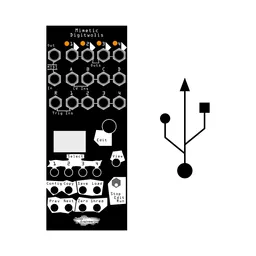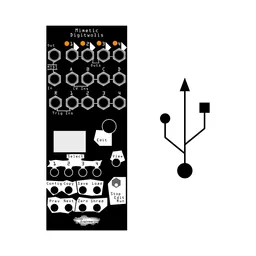Last week, we added three new plugins to our lineup, each based on our Eurorack modules. Bundle 2 contains Loquelic Vereor, a versatile complex oscillator synth; Manis Iteritas, a beautiful and/or industrial beast of a synth; and Imitor, a multitap delay playground and the focus of today’s blog. You can learn more about all three plugins (and purchase them!) here, and we’ll do a deep dive into Loquelic Vereor and Manis Iteritas a future post. But today? Today, we’re talking about Imitor. If you like delays, you’ll want to read this one.

What is a multitap delay?
Multitap delays are a useful, if obscure, style of delay: multiple parts of the delay line can be “tapped” (listened to) at once, effectively giving different delay times from a single delay unit. By changing the spacing, level, and panning of these taps (or even turning off taps completely), extremely complex echo patterns can be created unlike anything you’ve heard before.
Imitor's tap display shows this behavior: as audio runs through the delay, you'll hear an echo each time sound hits one of the tap indicator lines.

Build your own delay
Imitor is quite capable as a traditional delay: just set tap count to 1, set your Time and Pre Delay to taste, then play with Regen to change the number of echoes. Add in some filtering with the Tone controls, try out the Shimmer and Doom to add some flavor, and Imitor can act like a well-featured single-tap delay. It’ll even sync to the tempo of your DAW in any sort of division you like! We’ve included some presets to help you find your way here (see the category “bread-and-butter”), but Imitor is pretty intuitive once you start moving sliders.
Things get wild when we add in more taps, though. Imitor can have up to 32 taps, and we can change how different taps behave, modulate them, or completely disable them to create unique delay patterns and rhythms.
One of my favorite ways to use Imitor is to turn Regen all the way down, set the Tap Count to the number of echoes I want to hear, then tweak the other controls in the Tap Structure column to precisely adjust the timing, level, and panning of each echo. This won’t give you anything too out there, but it’s a very controllable way to work with delays. It’s also a great way to start playing with echo rhythms: disable a few taps with the Tap checkboxes and you’ll immediately get some interesting patterns.
Creating custom combs and choruses
Along with the complex modulation system included in all our plugins, Imitor also includes a dedicated tap LFO section. In my sessions, I tend to use it for two main things: adding stereo width by modulating the left and right signals separately, and adding some warble to a static delay if an instrument needs some excitement. It can also get into audio range and create some wild effects, perfect for atmospheres and backgrounds.
That’s just the tip of the iceberg, though: almost every parameter in Imitor can be modulated by an LFO, a step sequencer, or a macro control, which opens up a lot of possibilities for more extreme results.
And that’s just in the world of standard delay times: many audio effects (like comb filters, flangers, and choruses) are created with delays under 50 milliseconds and some modulation. Imitor’s delays can go below 1 millisecond, so it’s perfect for creating your own custom effects. Crank down the Time slider, turn up the Index, and enjoy some truly experimental sound design. You can even tune the Time parameter to match the pitch of incoming audio, creating some unique resonant effects!
The history of Imitor
Imitor started out as the Imitor Versio, our take on a multitap delay in the Eurorack format. We wanted a compact and simple-to-use interpretation of the traditionally complex effect, and Imitor Versio’s control structure was designed for easy tweaking and immediate results.
When we took Imitor to the software world, we were lifted from the constraints of hardware (Imitor Versio had seven knobs and two switches) and so we decided to expand the number of parameters and add in more ways to granularly control the delay structure, while still maintaining that easy-to-use workflow. Along with expanding the panning and modulation controls, we added the tap disable checkboxes: this was a feature that didn’t lend itself to a hardware interface, but is trivial and useful in software.
After we had an initial version of the plugin, we started testing: all of us ended up having many suggestions, and the plugin expanded quite a bit early on. The hardware version had 12 taps, and we expanded that to the 32 you see today. We also reduced the minimum delay time quite a bit, which greatly increased Imitor’s potential for audio-rate processing.
We’re very proud of Imitor: it’s a unique delay that takes a simple concept to its extremes while still being simple to navigate and fast to work with. Plus, it sounds awesome!
Don’t delay, try Imitor today
Imitor is available for purchase and immediate download now, either on its own or as part of Bundle 2 with Loquelic Vereor and Manis Iteritas. We’ll be doing a deep dive into the other plugins in Bundle 2, too, so check back soon for more!






